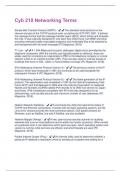Cyb 210 Networking Terms
Simple Mail Transfer Protocol (SMTP) - ✔️✔️The standard email protocol on the
internet and part of the TCP/IP protocol suite, as defined by IETF RFC 2821. It defines
the message format and the message transfer agent (MTA), which stores and forwards
the mail. It was originally designed for only plain text (ASCII text), but MIME and other
encoding methods enable executable programs and multimedia files to be attached to
and transported with the email message (PC Magazine, 2018).
T1 Line - ✔️✔️A 1.544-Mbps point-to-point, dedicated, digital circuit provided by the
telephone companies. With the monthly cost typically based on distance, these are
widely used for connecting an organization's PBX to the telephone company or a local
network (LAN) to an internet provider (ISP). They are also used for internet access in
buildings that have no DSL, cable, or fixed wireless coverage (PC Magazine, 2018).
IPv4 Addressing (Internet Protocol Version 4) - ✔️✔️The previous version of the IP
protocol, which was introduced in 1981 and continues to be used alongside the
subsequent Version 6 (PC Magazine, 2018).
IPv6 Addressing (Internet Protocol Version 6) - ✔️✔️The latest generation of the IP
protocol. The specification was completed in 1997 by the Internet Engineering Task
Force (IETF) and first deployed in 2004 when the Internet Corporation for Assigned
Names and Numbers (ICANN) added IPv6 records to its DNS root servers for Japan
and Korea. IPv6 is backward compatible with IPv4 and was designed to fix its
shortcomings, such as data security and maximum number of user addresses (PC
Magazine, 2018).
Netstat (Network Statistics) - ✔️✔️A command-line utility that reports the status of
TCP/IP and Ethernet connections. It comes with all major operating systems, but the
Linux/Unix versions provide the most command options. GUI-based versions for
Windows, such as NetStat Live and X-NetStat, are also available.
Network Mapper (Nmap) - ✔️✔️A free, open-source security scanner for auditing
networks that runs on most platforms and is written by Fyodor (a person). When aimed
at a particular host, it can determine which ports are open, which operating system and
version is running, what services are offered, and what firewalls are used (PC
Magazine, 2018).
Packet Internet Groper (Ping) - ✔️✔️An internet utility used to determine whether a
particular IP address is reachable online by sending out a packet and waiting for a
, response. It is used to test and debug a network as well as see if a user or server is
online (PC Magazine, 2018).
Hypertext Transfer Protocol (HTTP) - ✔️✔️The communications protocol used to
connect to web servers on the internet or on a local network (intranet). Its primary
function is to establish a connection with the server and send HTML pages back to the
user's browser. It is also used to download files from the server either to the browser or
to any other requesting application that uses HTTP (PC Magazine, 2018).
Secure Shell (SSH) - ✔️✔️A security protocol for logging into a remote server. It
provides an encrypted session for transferring files and executing server programs. Also
serving as a secure client/server connection for applications such as database access
and email, it supports a variety of authentication methods.
Voice Over IP (VoIP) - ✔️✔️A digital telephone service that uses the internet for
transport, as well as private IP networks. IP stands for "internet protocol." In order for
calls to originate and terminate from regular telephones, connections to the public
telephone network (PSTN) are also provided. Telephone companies, cable companies,
and dedicated providers offer this type of calling for a fixed monthly fee or low per-
minute charge. Customers must have existing internet access (PC Magazine, 2018).
Demilitarized Zone (DMZ) - ✔️✔️A middle ground between an organization's trusted
internal network and an untrusted, external network such as the internet. Also called a
"perimeter network," it is a subnetwork (subnet) that may sit between firewalls or off one
leg of a firewall. Organizations typically place their web, mail, and authentication servers
in it. It is a military term that refers to the area between two enemies (PC Magazine,
2018).
Local Area Network (LAN) - ✔️✔️A communications network that is typically confined
to a building or premises. The "clients" are user workstations running the Windows,
Mac, or Linux operating systems, while the "servers" hold programs and data shared by
the clients. Servers come in a wide range of sizes, from PC-based servers to
mainframes (PC Magazine, 2018).
Personal Area Network (PAN)`
Transmitting data wireless over a short distance. Bluetooth and Wi-Fi Direct are
examples of this (PC Magazine, 2018).
Protected Enclaves - ✔️✔️Subdivision of the internal network so that it is not one large
zone with no internal protections. This architectural approach to information security
defense in depth can be accomplished in a number of ways, including network
admissions control, firewalls, VLANs, and VPN (Northcutt, n.d.).




